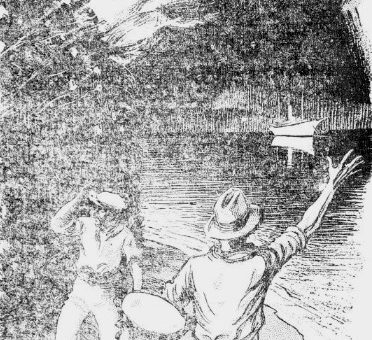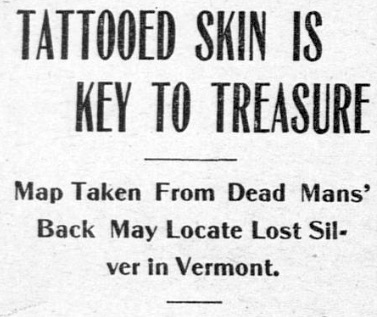
No, this is not a fictional story made up for thrill seekers, but an actual series of events that led one man to get an old treasure map tattooed on his skin. Having not found the treasure, the man on his deathbed, requested that the tattooed map be removed and given to a friend.
The following report was published in 1903:
Tattooed Skin Is Key To Treasure

Herbert Coventry, who says he comes from London, England, and is a solicitor, arrived in this town on his way to Bristol, whither he goes in search of the treasure house of the Algonquin Indians, which, according to tradition, is located in hidden caves in the south side of South Mountain.
Like most of his predecessors, Coventry has a map which he is sure will guide him to piles of silver ingots supposed to have been originally discovered by one De Grau, a Spaniard, nearly 200 years ago.
And a gruesome affair this map is, for the outline and locations are all tattooed on human skin.
It was this map that first called attention to the hunter.
Coventry said that several ears ago he met in the London slums a Spaniard suffering from an incurable disease. He saw to it that he was properly cared for in a public hospital. The man said that his family had formerly been wealthy, and once he declared that if he could get well enough to go to America he would soon recoup his fortunes.
One day Coventry was summoned to the hospital, as his friend was dying. The man asked the surgeon to withdraw and then said:
“There are enough silver ingots in a hidden chamber in the sire of an American mountain to make a dozen men fabulously rich. I am a descendant of Robert de Grau, who, 200 hundred years ago, discovered the treasure house of the Algonquin Indians, near Bristol, Vermont. The tribe was fleeing from the Iroquois. Attempting to save his own life and that of his son, my ancestor stumbled upon the treasure in a secret cavern. Part he took to Spain, where he became immensely wealthy and a power in the kingdom. He intended to take the rest, and started for America, carrying with him a map of the mountain.
“On the way over he was taken ill, died and was buried at sea. The map fell into the hands of the first mate, and he took up the search. He found the spot on the mountain, but a landslide had obliterated the mouth of the cave and he was never able to locate the treasure.
“The mate eventually died, and the map passed through several hands. It came to me in a most peculiar way. About ten years ago, while cruising off the coast of India, I befriended an old sailor. He gave me the map, which I immediately recognized as the one drawn on sheepskin by my ancestor. He said he got it from a sailor.
“The parchment was badly worn and so discolored that the drawing were almost obliterated. I suggested that a copy could be made on paper, whereupon the sailor declared that he knew of a scheme whereby the precious outlines could never be lost.”
Coventry said that the man pulled up his shirt, rolled over on his chest, and there, between the shoulders, was the map tattooed in the skin.
“‘When I die, I want the surgeon to remove the skin and give it to you.’ he said to me. ‘If you follow it up you will be a rich man.’ He called in a surgeon and made him swear that he would carry out his wish, and then he seemed easier. That night he died, and later the map was turned over to me.
“I didn’t think much of the man’s story at the time, and laid the ‘parchment’ away with private papers.
“I discovered that the man’s story, so far as his ancestor’s search was concerned, was true, and, further, that the Algonquins did lose their treasure during the Iroquois raids. Other facts have come to my knowledge, and I am now confident that the ingots are in the treasure house. I shall search for them all summer, if necessary.”
While Coventry is somewhat mixed in his data, it is nevertheless true that many believe the Indian treasure still lies in a hidden vault and comprises untold wealth. So strong was this belief several years ago that several business men of Montpelier organized a stock company to remove the rocks at the mouths of the caves. This proved impossible, and drilling was resorted to. After $20,000 had been spent the enterprise was abandoned. The entire face of the ledge is honeycombed with holes and shafts.
Source: The Saint Paul globe. (St. Paul, Minn.), 13 Sept. 1903.

